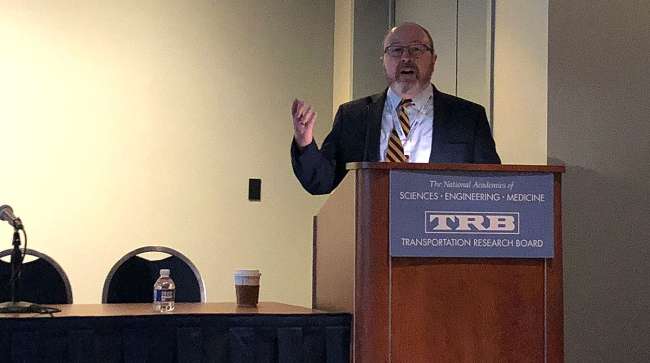Staff Reporter
FHWA Specialists Identify Resources for Public

[Stay on top of transportation news: Get TTNews in your inbox.]
WASHINGTON — The Federal Highway Administration offered attendees of the Transportation Research Board’s annual meeting an update of the resources the agency has made available.
The session, held Jan. 15, outlined resources such as data tools and strategic plans. Birat Pandey, an analyst within FHWA’s Office of Freight Management and Operations, explained these resources were primarily developed to reach a national audience and could be useful at the state, local or private level.
“These are resources that can offer a great start for many freight analyses,” Pandey said.

Chandra Bondzie by Eleanor Lamb/Transport Topics
FHWA Transportation Specialist Chandra Bondzie discussed a new federally owned database of information that allows users to visualize the National Freight Highway Network. The visualization tool relies on data pooled from the Primary Highway Freight System (PHFS), interstates that aren’t included in the PHFS and routes that are designated Critical Urban and Rural Freight Corridors.
Bondzie said the mapping tool is very specific and allows user to study small segments of road. The data will be updated annually.
As an upcoming activity, Bondzie said the Office of Freight Management and Operations will continue to improve the data’s accuracy.
“On the data side, we all know 100% accuracy is a very expensive, lengthy path,” Bondzie said. “However, that tends to be a customer expectation.”
Jeff Purdy, a transportation specialist with FHWA, pointed listeners to the National Performance Management Research Data Set, which people can use to access travel times for trucks and passenger vehicles on the National Highway System. He noted that this tool, which is updated monthly, can be especially useful for the freight and logistics industry, which relies on on-time deliveries.
“Predictable travel times are essential to freight,” Purdy said.
Purdy noted that performance measures related to freight are linked to issues such as safety and infrastructure. He discussed two types of delays on highways: recurring congestion, caused by capacity problems such as bottlenecks; and non-recurring congestion, caused by impediments such as work zones, traffic incidents and weather.
“In a lot of the major metropolitan areas around the country, that non-recurring congestion can contribute as much or more than the standard recurring congestion,” Purdy said. “That non-recurring congestion, because of its unpredictability, can be even more problematic in terms of movement of people and goods because it causes unexpected delays in the transportation system.”
More From TRB
Caitlin Hughes, director of FHWA’s Office of Freight Management and Operations, reminded listeners that the Department of Transportation is seeking public comment to help craft a National Freight Strategic Plan.
The National Freight Strategic Plan, required by the Fixing America’s Surface Transportation (FAST) Act, is meant to help inform infrastructure planning and support the efficiency of freight movement.
States and Washington, D.C., must also make freight plans, which FHWA Transportation Specialist Tiffany Julien described as a critical resource. Among the stipulations spelled out in the FAST Act are requirements that the plans identify significant freight system needs, offer an inventory of facilities with mobility issues (such as bottlenecks), and present a list of priority projects and their corresponding investment plans.
Want more news? Listen to today's daily briefing:




